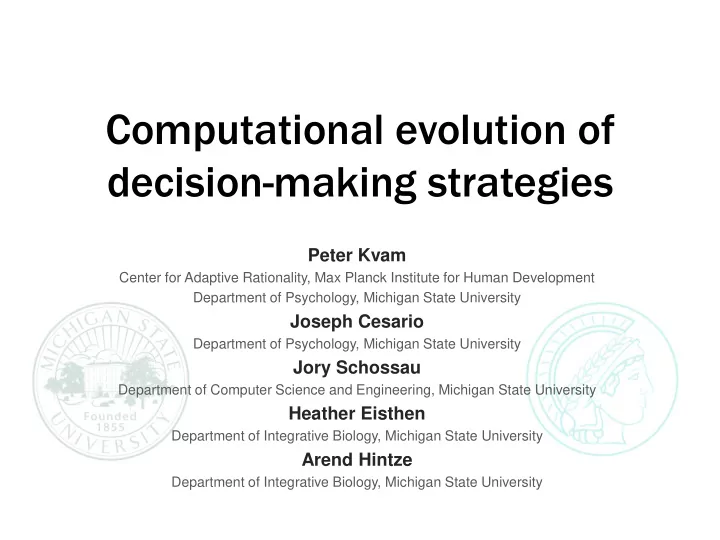

Computational evolution of decision-making strategies Peter Kvam Center for Adaptive Rationality, Max Planck Institute for Human Development Department of Psychology, Michigan State University Joseph Cesario Department of Psychology, Michigan State University Jory Schossau Department of Computer Science and Engineering, Michigan State University Heather Eisthen Department of Integrative Biology, Michigan State University Arend Hintze Department of Integrative Biology, Michigan State University
Introduction • We often take a strategy-first approach when constructing decision-making models – Assume optimal, approximately optimal, specific heuristics, utility-based, or other principled strategy – Then see what practical limitations are and in what environments it succeeds – Success = strategy is adaptive • This is a bit backwards – In reality, strategies are adaptive because they arise from the environment, not vice versa – We instead take the opposite approach, examining strategies that evolve in response to task environment
Introduction 𝜾 • Computational evolution approach – Evolve artificial agents using mechanisms that are similar to natural selection – Guarantees adaptive strategies – Biologically based agents easy to 𝜺 implement on neural hardware • Allows us to evolve decision-making strategies and compare against existing theories – More complex / more information used • Optimal sampling models (e.g. high- threshold diffusion) – Less complex / less information used • Heuristic strategies (e.g. run rules)
Goals • Examine a common task that animals in almost every ecological niche have to solve – Binary perceptual decision • Incoming information is from source A or source B -- agent must determine which one • e.g. predator / prey, edible / inedible, track A / B – Optional stopping (agent terminates search) • Examine strategies that they develop – Examine structure of their brains – Behavioral accuracy, brain complexity, amount of information use
Methods • Task – Discriminate between sources of incoming information – Comes from either majority [01] (right) or majority [10] (left) • Agents – Markov brains (16-bit) • Have 16 nodes, used for input, processing, output of information • Nodes are causally connected via logic gates • Genetic code gives rise to pattern of connections
Markov Brain
Markov Brain Inputs come from: A) N% 1s on left, N% 0s on right B) N% 0s on left, N% 1s on right Difficulty manipulated by changing N (high [e.g. 90] = easy, low [e.g. 60] = difficult)
Markov Brain N = 90%, LEFT on this trial 81% 9% 9% 1% Difficulty manipulated by changing N (high [e.g. 90] = easy, low [e.g. 60] = difficult)
Markov Brain Organism has to indicate which one using its output nodes
Markov Brain
Markov Brain
Markov Brain
Markov Brain
Markov Brain
Markov Brain
Setup • 100 organisms per generation – Each one has its own genome and node structure • Each organism makes 100 left [10] / right [01] decisions during its lifetime (actual direction is random) – Gains points for every correct answer, loses points for incorrect • Reproduction based on performance (roulette wheel) – Offspring accumulate mutations in genome to set node structure – Poor performers simply die off without reproducing
Data • Focus on manipulations of difficulty • Fitness – asymptotic performance of population • Brain size - # of connections between nodes in the artificial brains • Strategy use – how much information do the agents use, and how long do they gather it?
Fitness 90% 85% 80% 75% • Agents achieved near- perfect accuracy in most conditions except most difficult • Even then, worst performance was 70% 65% 60% ~80% accuracy
Strategies • Simple heuristic strategies – Should use very little information – Terminate search early – Small brains • Complex evidence accumulation strategies – Should use a large amount of information – Gather information over a protracted period – Large brains
Results – brain size • Brain size – Generally larger in more difficult conditions – Response to more demanding task environment • Brains decreased in size when the task was easy – Despite no explicit cost for more connections – Seems to result from the mutation load imposed by larger brain
Results – strategy use • More difficult conditions led to more information use – Agents also gathered information over a more protracted period
Conclusions • Difficulty of task environment plays a huge role in evolutionary trajectory of artificial agents – Behavior scales based on environmental demands, – Not strictly based on optimal decision strategies • Agents in difficult conditions evolved large brains, integrated lots of information over a protracted period – Strategies resembled complex sequential sampling strategies • Agents in easier conditions evolved smaller brains, used relatively little information – Brain size seems to be limited by mutation load – Strategies resembled 2-run / 3-run heuristic rules
Bonus slides • Surface plots – Brain size – Memory (self loops) – Memory (back-and-forth loops) – Mean decision time • Cost-benefit payoff manipulations • 1000 tick results – % correct – Fitness – Decision time
Brain size
Memory – self loops
Memory – back-and-forth loops
Waiting times
Cost-Benefit manipulations
1,000-tick Results - # Correct
1,000-tick Results - Fitness
1,000-tick Results – Decision time
Recommend
More recommend